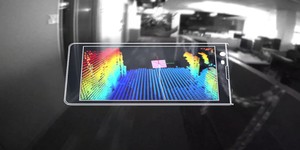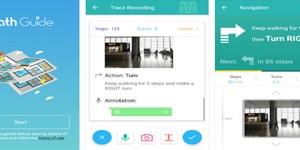
Google has released details of a prototype Android smartphone which contains a novel feature: the ability to sense motion and depth through a Kinect-like camera system.
Dubbed Project Tango, the Android-based smartphone prototype is perhaps a little bulky at present - but that's largely excusable when you get a glimpse at what's gone into its creation. As well as the normal guts of a smartphone, the 5in device packs a standard four-megapixel camera, a depth sensing unit, and a secondary motion-tracking camera alongside a co-processor dubbed Myriad 1 from Movidius.
It's this co-processor that allows the Tango to sample its position and depth data from its surroundings up to 250,000 times per second without draining the battery - an issue that had previously prevented companies like Apple, which acquired Kinect creator PrimeSense late last year, from releasing a product featuring the same depth-sensing technology.
While gaming will be a big driving force for the sensor data provided by Tango - a demonstration video shows a glimpse of an engineer trialling an augmented reality game which overlays a forest on top of the real-world environment, while another game rolls a virtual ball down a real-world ramp - Google has bigger visions for the technology. Suggested uses include quick mapping of indoor spaces, such as your living room prior to a furniture purchase, by simply waving the phone around; indoor GPS-style directions accurate enough to find you a particular product on a particular shelf of a supermarket; and even the ability to allow the partially sighted or even outright blind to easily navigate an unfamiliar environment.
Sadly, Google is keeping quiet on how far the technology is from commercialisation, or even whether it plans to release a product based on the system at all, but claims it will be distributing a number of Tango development kits in the coming months. The company has also offered a teaser video showing what the current prototype can do, reproduced below.
Dubbed Project Tango, the Android-based smartphone prototype is perhaps a little bulky at present - but that's largely excusable when you get a glimpse at what's gone into its creation. As well as the normal guts of a smartphone, the 5in device packs a standard four-megapixel camera, a depth sensing unit, and a secondary motion-tracking camera alongside a co-processor dubbed Myriad 1 from Movidius.
It's this co-processor that allows the Tango to sample its position and depth data from its surroundings up to 250,000 times per second without draining the battery - an issue that had previously prevented companies like Apple, which acquired Kinect creator PrimeSense late last year, from releasing a product featuring the same depth-sensing technology.
While gaming will be a big driving force for the sensor data provided by Tango - a demonstration video shows a glimpse of an engineer trialling an augmented reality game which overlays a forest on top of the real-world environment, while another game rolls a virtual ball down a real-world ramp - Google has bigger visions for the technology. Suggested uses include quick mapping of indoor spaces, such as your living room prior to a furniture purchase, by simply waving the phone around; indoor GPS-style directions accurate enough to find you a particular product on a particular shelf of a supermarket; and even the ability to allow the partially sighted or even outright blind to easily navigate an unfamiliar environment.
Sadly, Google is keeping quiet on how far the technology is from commercialisation, or even whether it plans to release a product based on the system at all, but claims it will be distributing a number of Tango development kits in the coming months. The company has also offered a teaser video showing what the current prototype can do, reproduced below.

MSI MPG Velox 100R Chassis Review
October 14 2021 | 15:04








Want to comment? Please log in.